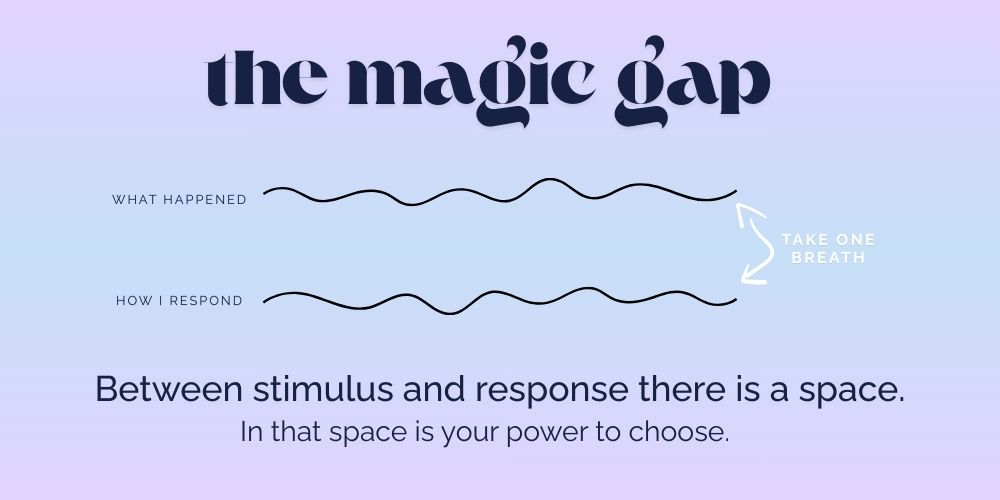Have you ever snapped at your child and immediately thought, “That’s not who I want to be as a parent”?
You’re not alone. As a stress coach working with overwhelmed parents for nearly a decade (and as a parent myself!), I’ve seen firsthand how quickly we can go from calm to reactive when our buttons get pushed.
But what if I told you that the secret to breaking this cycle isn’t about learning more techniques or trying harder?
It’s about something I call the magic gap.
What Is the Magic Gap?
Holocaust survivor and psychiatrist Viktor Frankl famously said:
“Between stimulus and response there is a space. In that space is our power to choose our response. In our response lies our growth and our happiness.”
That tiny space—that magic gap—between when something happens (your child spills milk for the third time) and how you respond to it (deep breath vs. frustrated outburst) is where all your power as a parent lives.
Most of us rush right through this gap without even realizing it exists. Something triggers us, and we react automatically from stress, past patterns, learned response from our own parents, or sheer exhaustion.
But when we learn to widen this gap—even by just 3 seconds—everything changes.

Why Parents Get Stuck in Reactivity
As parents, especially those of us juggling multiple roles and responsibilities, our nervous systems often operate in a state of chronic stress. This means we’re constantly in “threat detection” mode, which significantly narrows our magic gap.
When we’re stressed:
- Our prefrontal cortex (the rational, thoughtful part of our brain) goes offline
- Our amygdala (emotional, reactive brain) takes over
- We react based on old patterns rather than our values and intentions
This is why you can know all the “right” parenting techniques and still find yourself yelling, criticizing, or threatening—especially when you’re tired, overwhelmed, or triggered.
The good news? You’re not failing as a parent. Your nervous system is just doing what it’s designed to do under stress.
How to Widen Your Magic Gap
Widening the magic gap doesn’t require hours of meditation or complicated techniques. It starts with just one conscious breath in moments of stress.
Here’s a simple practice to begin:
- Notice your triggers: Pay attention to when you start feeling that familiar tension in your body (tight chest, clenched jaw, racing heart).
- Name it: Silently acknowledge, “I’m feeling triggered right now.”
- Take one breath: Inhale slowly through your nose, exhale through your mouth. Just one.
- Now choose: From this slightly calmer state, choose how you want to respond based on your values, not your stress.
That’s it. One breath might sound too simple, but that single breath creates the magic gap that allows you to respond thoughtfully rather than react automatically.
The Magic Gap in Real Life
Last week, my son was completely ignoring me while I was trying to get us out the door (a classic trigger for my stress response). I felt that familiar tension rising in my chest and the words “Why aren’t you listening to me?!” forming in my throat.
But instead of letting those words fly out, I noticed the gap. I took one breath. In that tiny pause, I remembered that he’s not trying to drive me crazy—he’s just focused on what matters to him right now.
So instead of my automatic frustrated reaction, I walked over, got down to his level, and gently put my hand on his shoulder to make the connection before speaking.
The result? We both stayed calm, got out the door just fine, and I didn’t spend the car ride mentally beating myself up for losing my cool (again).
Beyond the Breath: The Values Connection
The magic gap isn’t just about calming down—though that’s certainly helpful. It’s about creating space to align your responses with your authentic values as a parent.
In that tiny pause between trigger and response, ask yourself:
- What kind of parent do I want to be in this moment?
- What message do I want to send to my child about handling difficult emotions?
- How can I stay connected to my child while still addressing the behavior?
Over time, this practice helps you discover who you truly are beneath the stress, reactivity, and self-criticism that often cloud parenting.
Start Small, See Big Changes
The magic gap practice isn’t about being a perfect parent. It’s about giving yourself that tiny bit of space to choose who you want to be in challenging moments.
Try this today: The next time you feel triggered by something your child does, see if you can notice the gap between the trigger and your response. Just take one conscious breath in that space. That’s it!
Then notice what shifts—both in how you respond and in how you feel about yourself afterward.
Where to go from here:
- Free Inner Voice Makeover workbook: Transform harsh self-talk into self-compassion with these 5 powerful steps to speak to yourself like someone you love. Discover the values hidden beneath your inner critic.
- 21 Day Meditation-in-Action: Retrain your brain in just 4 minutes daily. Create the mental space needed to connect with your authentic self and make values-aligned decisions.
- 1:1 Discovery Session: End the cycle of reactivity that leaves you feeling guilty, drained, and disconnected from your authentic self. In this focused 30-minute free consultation, we’ll identify your unique stress triggers and create a clear path to the calm response patterns you’ve been searching for. Transform stress into strength—starting now!






Article Comments